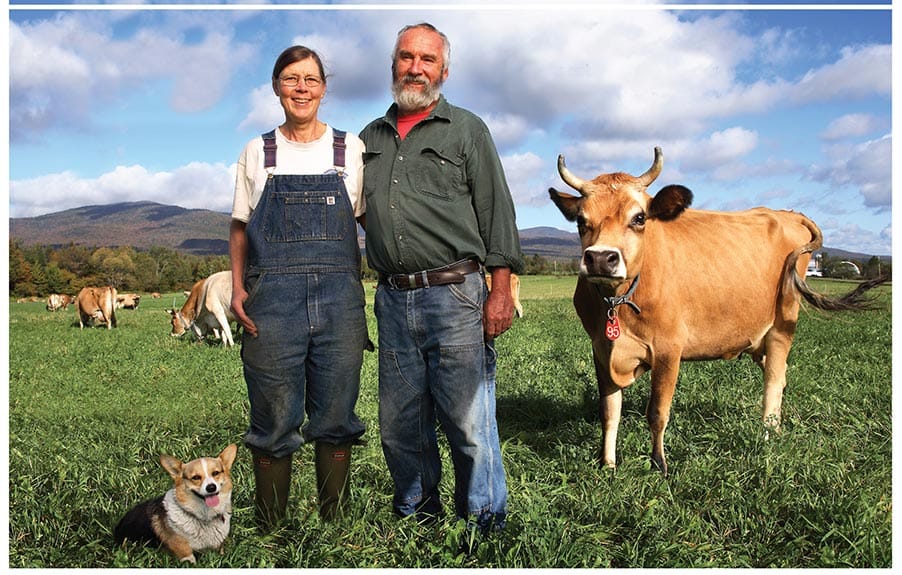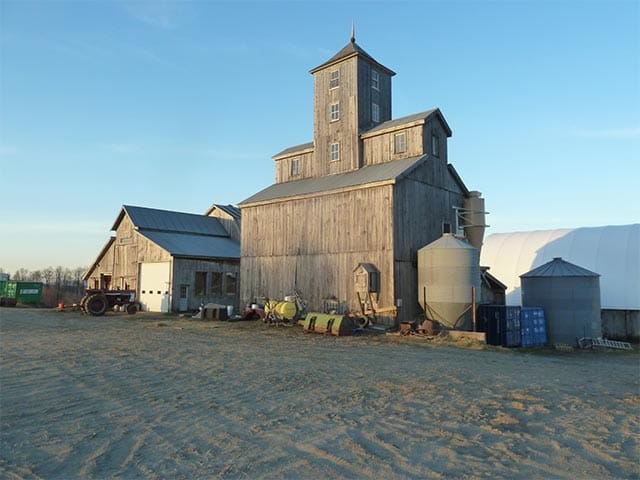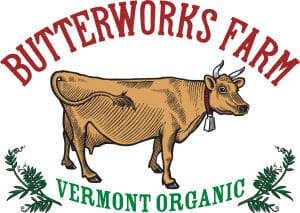Organic Yogurt the Offspring
[This article was previously published in the fall issue of The Cultivator, Cornucopia’s quarterly newsletter.]
by Rachel Zegerius,
Communications and Development Associate at The Cornucopia Institute
 |
This year, however, they transitioned the cows Photo courtesy of Shawn G. Henry |
The Lazors have been farming in the Northeast Kingdom of Vermont since the late 1970s, when they processed milk from their two family cows on the stovetop in their farmhouse kitchen. Early on, their local delivery route consisted of 35 families receiving eggs, raw milk, butter, farmer’s cheese, and – their ambrosial, signature product – yogurt.
He notes that she’s the one with common sense who interjects reality into any situation, while she ascertains that he’s the dreamer and the charm behind the legend that is Butterworks Farm. You might not meet a more dynamic dairy duo than Jack and Anne Lazor. “I’m Mr. Giddyup and she’s Madam Whoa,” says Jack.
Today, Butterworks Farm yogurt is one of the most widely recognized organic brands on shelves across the Northeast. Cornucopia has given the product its highest and most reputable, 5-spoon, rating on its yogurt scorecard, designed to educate consumers about the best and worst organic brands available. (Visit: cornucopia.org/yogurt-scorecard/)
Captivating more dedicated customers each year, it’s hard to pinpoint just which of Butterworks Farm’s unique characteristics makes their yogurt stand out.
It could be the heritage strains of cultures, grown weekly and used in the fermentation process. Or, maybe it’s the high content of fat and solids found in their grass-fed cows’ milk that give it the rich flavor for which it’s known. Alternatively, could it be yogurt-maker Theresa’s special skills that bring the magic?
While all of these factor are sure to deliver, one thing is for certain. Umbilical to Butterworks’ success is a commitment to the land itself: soil vitality.
Over the years, despite changes in their farming approach, dairy production, and business practices, the one thing that has endured is a perennial commitment to balancing nutrients, trace minerals, organic matter, and soil life.
“Developing the whole farm organism is the most important thing here,” says Jack. The Lazors recognized the symbiosis early on.
In the mid-1980s, with their Vermont milk handlers’ license approved and their yogurt on shelves across the state, the Lazors invested heavily in minerals for their land.
“The payback was almost immediate,” says Jack. Diversity and yield of browse increased in the hayfields. The health and general well-being of cows improved, and milk production increased.
“Thus began my love affair with soil,” he explains. “All I needed to do was to take care of it, and it took care of us. This was such a revelation to me. I very quickly realized that balanced mineral inputs do not cost—they actually pay.”
Voilà, the terroir of Butterworks Farm, a by-product of this deep reverence and responsibility to care for the Earth. And, in turn, the Earth is taking care of them.
 |
Butterworks Farm has sustained itself for four decades and now grosses nearly $1.2 million each year. They currently have a total of 85 dairy cows, including 43 milkers, and this year they transitioned from a system of feeding the cows both grain and hay to one of 100% grass-fed diets for all of their adult cows.
The high levels of forage quality in their fields – diversity, high energy, and high protein – have enabled the Lazors to stop feeding grain to their cows altogether. Such grass-based systems build soil carbon and, in the case of Butterworks, may lead to no-till grain systems in the future.
Implementing innovations like these, Jack and Anne Lazor are true organic pioneers. And, as mentors in the movement, they have encouraged years of development in local production, local food, and…local competition.
Not only do giant organic counterfeit corporations pose unfair competition, but increasing numbers of small New England dairies also make it harder to succeed in today’s market. “We can’t complain about that though, because it’s really the best thing for communities to each have their local food supply,” says Anne.
But, distribution and profitability have declined over recent years. And, having been removed from the shelves of Whole Foods in the greater D.C. and New York regions as of late, Butterworks is reimagining a successful vision moving forward.
“We rode the wave and now the wave has crested,” says Jack. So, the Lazors have spent the last several months doing a lot of soul-searching, digging deep to unfold the riddle of their future path – both personally and for the fate of the business.
“We grew and grew for a while, but maybe now we’re thinking one of our options is to shrink,” says Anne. Strategies moving forward may include developing even more relationships and markets throughout Vermont and New Hampshire, a focus on being THE local brand.
If there is any one thing that Butterworks aims to be, it’s an alternative to corporate organics. What will become of the Lazors legacy plan? Only time will tell.
“We are definitely marching to the beat of a different drummer,” says Jack. And, in a profit-driven economy that often deemphasizes and externalizes the value of diverse ecology and sustainable natural systems, the Lazors see themselves as part of an “ascending spiral.”
The unifying force that connects every living and non-living organism in their farm ecosystem takes root in Love of the Earth. “It’s pretty idyllic,” observes Jack.
His definition of farming? Producing food for people out of love. Jack chuckles, “The entire farm is bathed in love.”
Remember that when you take your next spoonful of Butterworks Farm maple yogurt.


